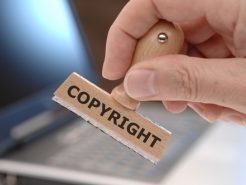Currently, infringement of intellectual property rights is a common problem. A trademark is an object of intellectual property, and it is very common to have a trademark infringement. So, what behavior is considered an infringement of trademark rights?
Trademark infringement acts
The 2005 Intellectual Property Law stipulates that an act of infringement of trademark rights in Article 129, according to which, the following acts performed without the permission of the trademark owner shall be considered as infringement of with the mark:
– Using a sign identical to a protected mark for goods or services identical to those on the list registered with that mark;
– Using a sign identical to a protected mark for goods or services similar to or related to the goods or services on the list registered with that mark, if such use is likely to cause confusion. origin of goods and services;
– Using a sign similar to the protected mark for goods or services that are identical, similar or related to the goods or services on the list registered with that mark, if such use is possible. causing confusion about the origin of goods or services;
– Using a sign that is identical or similar to a famous mark or a sign in the form of a translation or transliteration of a famous mark for any goods or service, including identical or dissimilar goods or services. self and not related to goods or services on the list of goods or services bearing a well-known mark, if the use is likely to cause confusion about the origin of the goods or cause a false impression of the relationship between its user and the owner of a well-known trademark.
Bases for determining infringement
Decree 105/2006 / ND-CP has provided the basis for determining the infringement. Accordingly, an act shall be considered an infringing act when there are all the following grounds:
– Subject to be considered belongs to the scope of objects being protected of intellectual property rights.
– There is an infringing element in the subject being considered.
– The person performing the act to be considered is not the owner of intellectual property rights and is not a person authorized by law or a competent authority under exceptional circumstances.
– The considered behavior occurred in Vietnam. The considered behavior is also considered to occur in Vietnam if it happens on the internet but is aimed at consumers or private users in Vietnam.
Factors that infringe trademark rights
An infringing element of trademark rights is a sign affixed to goods, goods packages, service means, transaction papers, signboards, advertising means and other means of business, identical or similar. to the point of causing confusion with a protected trademark.
Bases for consideration of an infringing element of trademark rights are the trademark protection scope, including the model of the mark and the list of goods and services identified in the Certificate of Trademark Registration or Label Certificate. International registration marks are protected in Vietnam.
In order to determine whether a suspected sign is an infringing element of trademark rights, it is necessary to compare that sign with the trademark, and at the same time the products or services bearing such mark must be compared with products and services under the scope of protection. An invasive element can only be confirmed when the following two conditions are met:
– Firstly, the suspected sign is identical or confusingly similar to a trademark under the protection scope; in which a sign is considered identical to a mark under the protection coverage if it has the same texture and presentation (including color); A sign shall be considered confusingly similar to a mark under the protection coverage if it has some characteristics that are completely identical or so similar that it is not easily distinguishable in structure or pronunciation. , transliterating for signs, words, meanings, presentation, colors and confusing consumers about goods or services bearing the mark;
– Second, goods or services bearing the suspected sign are identical or similar in nature or related in terms of function, utility and have the same consumption channel with the goods or services under the protection scope.
For a well-known mark, a suspected sign is considered an infringing element
– The sign is suspected of meeting the first condition;
– Goods or services bearing the suspected sign of meeting the second condition or the goods or services are not identical, not similar or related to goods or services bearing a famous mark but are capable of causing confusing consumers about the origin of goods or services or misleading the impression on the relationship between the producer or trader of such products or services with the owner of a well-known mark.
Note, if a product or service bears signs that are identical or difficult to distinguish in the overall structure and presentation in comparison to the protected trademark for the same type of product or service under the protection scope, it shall be considered. is counterfeit trademark goods. Counterfeit trademark goods are goods or packages of goods bearing a mark or signs that are identical or difficult to distinguish from a protected trademark or geographical indication, which is used for that product itself without permission of the trademark owner or the entity that administers the geographical indication.
Stipulate the case of limited ownership of trademarks
The rights of the trademark owner are as follows:
The right to prevent others from using the trademark
Trademark owner and authorized organizations or individuals have the right to prohibit others from using the mark unless it is used that is identical or similar to a protected geographical indication if that mark already exists. Obtain honest protection before the date that the geographical indication is filed.
Using a trademark means the conduct of the following acts:
– Affixing protected trademarks on goods, goods packages, means of business, means of services, documents of transactions in business activities;
– Circulating, offering for sale, advertising for sale, stockpiling for sale of goods bearing the protected mark;
– Importing goods and services bearing the protected trademark.
Obligation to use trademarks
The trademark owner is obliged to use that mark continuously. In cases where a mark has not been used continuously for five or more years, the ownership of such mark shall be terminated in accordance with the provisions on termination of protection title.
Above is the content that regulates trademark infringement. To avoid being compromised, use our reputable trademark registration service. Contact now for a free consultation.








